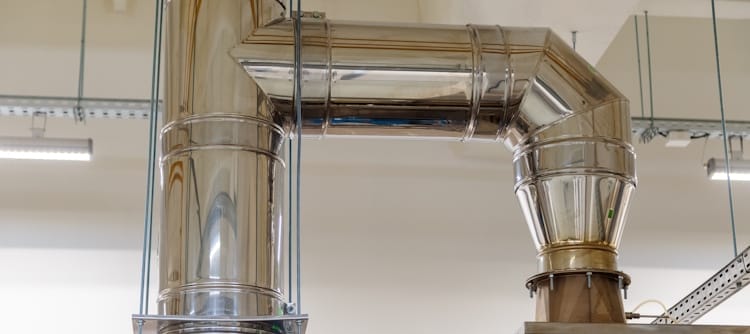Identify the Right Custom HVAC Products to Meet Your Facility’s Requirements
If your facility is preparing for a commercial HVAC installation, you may need guidance and support to help determine what’s necessary for your specific goals.
The terminology used in the commercial HVAC industry is its own language and, although the concepts behind them aren’t difficult to understand, entering new territory in an unfamiliar industry often requires an interpreter.
As you select an engineering and manufacturing team to build for your facility, the first distinction you want to make is between products for air distribution, such as grilles and diffusers, and air filtration equipment, like fan filter units. Knowing what each of these commercial HVAC subsets means cracks open an understanding of the specific products you will need to acquire for your project.
What Is Air Distribution?
Air distribution is the movement of air through the ductwork in an HVAC system. Large motor-controlled fans blow air into rooms through supply vents, guided by supply grilles, which angle air in a particular direction. Air distribution systems also stabilize and remove air through return vents and grilles and recycles air back through the system.
Air distribution products for commercial buildings are not much different from residential HVAC in concept, although commercial systems require more energy capacity and equipment functionality, while also addressing challenges informed by a building’s complexity.
What Buildings Require Air Distribution Systems and Products?
Commercial HVAC is generally required in all commercial buildings, per state or federal code requirements. This applies to retail spaces, office buildings, warehouses, industrial facilities, and other spaces that are used for business purposes. Noncompliance can result in legal or financial penalties.
Several organizations regulate commercial HVAC air distribution products and systems, including:
- The American Society of Heating, Refrigeration, and Air-Conditioning Engineers (ASHRAE).
- The International Code Council (ICC).
- The National Fire Protection Agency (NFPA).
- The International Association of Plumbing and Mechanical Officials (IAPMO).
Facility managers may also consider energy-efficiency certification through Leadership In Energy and Environmental Design (LEED). State governments typically provide resources through departments that handle design, construction, and compliance.
What Is Air Filtration?
Air filtration is the process of preventing harmful or unwanted particles from entering a commercial building’s environment.
Undesirable particles include:
- Viruses.
- Bacteria.
- Mold.
- Fungi.
- Allergens.
- Dust and debris.
- Wildfire smoke.
- Volatile organic compounds (VCOs).
Facilities attempt to reduce particle counts and improve indoor air quality (IAQ), a generalized metric used to help facilities benchmark and set goals to achieve a safe, healthy environment. For example, a healthcare facility might choose to improve IAQ to the point where a certain percentage of infections decrease year to year.
The most common filtration technique is the use of ULPA and HEPA filters, which collect particles on their surface, blocking them from passing through circulating air. Typically made from micro glass fiber paper, ULPA and HEPA air filtration are scientifically proven to reduce particle counts of common infectious particles, such as COVID-19 and predominant influenza (flu) viruses.
What Industries Require Air Filtration?
Much like commercial HVAC and air distribution systems, regulatory bodies and agencies govern air filtration standards based on agreed-upon industry expertise.
These industries have strict standards and codes for air filtration:
- Pharmaceutical manufacturing
- Medical device manufacturing
- Hospitals and healthcare
- Agriculture
- Biotechnology
- Automotive
- Microelectronics and nanotechnology
- Aerospace
- Optics
- Gene therapy
- Semiconductor and renewable energy manufacturing
- Data storage
- Labs and research facilities
Many industries also rely on their own codes and compliance benchmarks. For example, the pharmaceutical industry relies on the United States Pharmacopoeia. Healthcare depends on guidance from the American Society for Healthcare Engineering (ASHE), the American National Standards Institute (ANSI), and the American Society of Heating, Refrigeration, and Air- Conditioning Engineers (ASHRAE).
If your facility is taking steps to begin commissioning air filtration systems and products, an HVAC engineering and manufacturing company can help with:
- Identifying your regulatory needs.
- Selecting systems and products.
- Customizing these products specifically for your environment.
Can Industries That Only Require Air Distribution Still Benefit From Air Filtration?
Not all facilities that choose to address infection prevention or indoor air quality are required to comply with regulatory bodies or compliance organizations. Schools, retail spaces, office buildings, and other buildings that only require products for air distribution, such as grilles, may decide that the benefits of IAQ and infection prevention are useful.
These benefits include:
- Protective health measures for building inhabitants.
- Higher worker productivity.
- Better learning environments.
If you represent a facility that doesn’t necessarily require air filtration, but you wish to explore its benefits, consider these resources:

